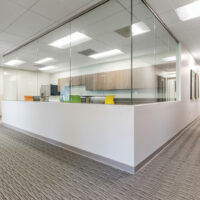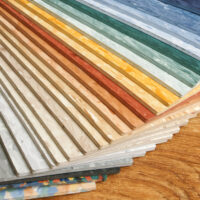Blog
View All Blog Postings
Dredging Up Drone Issues
There is a lot of talk these days about using drones to inspect exterior building walls. Aside from issues regarding safety, liability, federal regulations, etc. there is little doubt that up close video photography can be a helpful tool. Visual inspection using binoculars from ground-level or other vantage points is a basic part of exterior wall inspection and investigation procedures. This process can only benefit from the use of drones in terms of being able to quickly examine large areas with good quality imaging (documentation).
 However, any visual inspection is limited. An up-close inspection by a qualified inspector or engineer (using a roof-mounted swing stage, scaffolding, or a man-lift) provides the most reliable information possible by allowing the person to touch, probe, and sound (tap) areas of concern to check for delamination, stability, soundness, etc.
However, any visual inspection is limited. An up-close inspection by a qualified inspector or engineer (using a roof-mounted swing stage, scaffolding, or a man-lift) provides the most reliable information possible by allowing the person to touch, probe, and sound (tap) areas of concern to check for delamination, stability, soundness, etc.
In addition, having an individual “on the wall” allows for intrusive sampling needed to determine in-place, hidden conditions. Visual examination alone cannot fully evaluate these matters.
Yes, drones can be a valuable part of an exterior wall inspection and/or evaluation. We own a drone and use it for certain inspections. However, drones alone are not capable of providing all the information necessary to perform a complete and comprehensive investigation of exterior walls or building conditions.
Amenities for Condominium
 When buying a condominium or renting an apartment, amenity spaces have become an important aspect of resident’s comfort and lifestyle. In newer developments, as the size of the apartment is shrinking, it is the amenity spaces that become the home and outlet for activities. Traditionally, a residential building has a club room, weight room and an outdoor pool, which still serves well for many communities. However, in today’s market, buyers have many new interests and requirements. In general, the trend has been leaning towards spaces that suggest specific activity areas. Here is a list of growing trends in amenity spaces that has grabbed our attention.
When buying a condominium or renting an apartment, amenity spaces have become an important aspect of resident’s comfort and lifestyle. In newer developments, as the size of the apartment is shrinking, it is the amenity spaces that become the home and outlet for activities. Traditionally, a residential building has a club room, weight room and an outdoor pool, which still serves well for many communities. However, in today’s market, buyers have many new interests and requirements. In general, the trend has been leaning towards spaces that suggest specific activity areas. Here is a list of growing trends in amenity spaces that has grabbed our attention.
- A Play Room for kids is a place for kids to go, without going anywhere (outside the building). It provides a place for kids (as well as parents) to have fun, play and interact with their community. Rooms are specially designed to provide kid’s furniture and colorful room finishes.
- A Fitness Center that is more than just a weight room. It includes a cardio room, machine room, free weights area, yoga/ Pilates studio and a massage room. We have seen many of these rooms located on ground floor with large windows to allow plenty of sunlight and fresh air.
- Entertainment and Sports Lounge for the sports enthusiasts. Watching a game with friends and having a pizza is a great American tradition. This room provides a comfortable family room environment to kick back and enjoy a game with friends and family.
- Rooftop Sundeck-Pool and an Outdoor Kitchen have become essential for residents to escape their daily lives and enjoy the outdoors on their rooftop. Many buildings offer special catered events to celebrate 4th of July and have a great meal.
- Dog Wash Room is a very practical amenity for pet lovers. Dog hair can easily clog your bath tub and taking your pet to grooming shop get tiresome during freezing months. Why not have a dog wash and grooming room that takes care of your pet inside your building.
- A Vegetable Garden is an amazing addition to your backyard, so why not to your building. Growing vegetables provides a healthy choice for food and exercise for the residents. Although it requires maintenance plans and agreements between management and residents, it is worth the effort.
Avoid Flooring Problems
 Installing linoleum or similar covering directly on concrete floors can be problematic if there is moisture in the slab. This is especially a concern with on grade slabs where there may be moisture under the slab that can permeate upward. Linoleum and similar floor coverings act as a barrier that can cause moisture to be trapped under the flooring. When this happens, the floor covering can unbond, warp and become a serious hazard.
Installing linoleum or similar covering directly on concrete floors can be problematic if there is moisture in the slab. This is especially a concern with on grade slabs where there may be moisture under the slab that can permeate upward. Linoleum and similar floor coverings act as a barrier that can cause moisture to be trapped under the flooring. When this happens, the floor covering can unbond, warp and become a serious hazard.
Carpet covering will let moisture vapor pass through and normally are not a problem. Carpet can be a solution where other floor coverings are adversely affected by moisture.
If a linoleum or similar covering needs to be installed, it is important to understand and analyze the moisture present in and/or under the slab. Various types of moisture testing can be performed to help verify that the concrete is dry enough to allow the installation of an impermeable floor covering.
Making Wood Transparent
 Researchers at the University of Maryland have found a way to make wood transparent, which could change the way that we utilize this building material.
Researchers at the University of Maryland have found a way to make wood transparent, which could change the way that we utilize this building material.
http://mobile.nytimes.com/2016/05/12/science/see-through-wood.html?_r=3&referer=
Important Tips When Visiting a Construction Site
 Most importantly is your safety. Be sure to wear appropriate protection such as a hard hat, construction boots, yellow safety vest and safety glasses.
Most importantly is your safety. Be sure to wear appropriate protection such as a hard hat, construction boots, yellow safety vest and safety glasses.- Make an appointment with the contractor/management and be familiar with the overall layout, prior to your visit. Upon arrival check in with the construction site supervisor.
- Take photographs of the construction site and make field notes of your observations. Don’t forget to document date, time, project name and whom you met.
- Take along a 25-foot tape measure for field dimensions and a flash light for enclosed rooms that may not have electricity.
- The general contractor has authority and responsibility for the job site, therefore don’t direct workers, get in a debate or offer advice. It is best to state the purpose of your visit, make observations and be courteous
Two Hours of Super Powers
 We recently ran into an unusual item at a property – two hour, fire rated windows. The assemblies looked like “regular” windows but after some digging through the building drawings, it was determined that the windows were fire rated. The building code requires that exterior building walls within ten feet of a property line must be constructed using recognized fire rated assemblies. This includes the glazing.
We recently ran into an unusual item at a property – two hour, fire rated windows. The assemblies looked like “regular” windows but after some digging through the building drawings, it was determined that the windows were fire rated. The building code requires that exterior building walls within ten feet of a property line must be constructed using recognized fire rated assemblies. This includes the glazing.
Fire rated windows have special steel frames (fiberglass, vinyl and aluminum cannot stand up to the heat) and multiple layers of glass (up to about 1-1/4” thick) that allows them to provide protection against radiant heat, smoke, and fire. They have been tested to confirm their ability to resist fire and even the force of a fire hose stream in accordance with ASTM and NFPA standards.
Fire rated windows may look like a normal window, but these windows with super powers cost significantly (about 15 to 20 times) more than a standard window
Inspection Gadgets
 Advances in imagining and sonic technology have long been embraced by engineers and are being used every day to help evaluate buildings and building systems. These gadgets can allow for an in-depth, minimally invasive, and cost-effective inspection with rapid results. Plus, it is fun to pull out a toy that you might see in an action movie to help figure out a problem. The following are found in most local consultant’s arsenals.
Advances in imagining and sonic technology have long been embraced by engineers and are being used every day to help evaluate buildings and building systems. These gadgets can allow for an in-depth, minimally invasive, and cost-effective inspection with rapid results. Plus, it is fun to pull out a toy that you might see in an action movie to help figure out a problem. The following are found in most local consultant’s arsenals.
- Thermal Camera – Police, military, and ghost hunters use them and so do engineers. Infrared thermography allows us to “see” hot and cold areas and can allow for a rapid scan of a room, roof, electrical panel, radiator, or a building façade for thermal anomalies. These normally are found to be air and water leaks and help pinpoint locations that should be inspected more thoroughly. Blue areas are cold and red are hot.
- Drones – Unmanned flying aircraft now are easier to maneuver and can take high resolution digital video and photos, which allows for the inspection of a roof or building exterior when access is extremely difficult or limited. Government regulations are still in a state of flux related to this equipment, but the rules are getting clearer as time goes on.
- Ground Penetrating Radar – The same technology that allows police to scan a field for objects buried underground is used by engineers to emulate Superman and see what is in concrete. The 3-D version can generate an image of what is embedded in a concrete slab.
Impact-Echo – This device uses a special hammer and sound waves to measure the thickness of concrete and find buried defects that are not visible to the human eye by simply tapping the surface.
Moisture Meter – Used to measure the moisture content of wood, drywall, and other building materials to help narrow down if a water leak is active and where it may be coming from. - Boroscope – Spy movies show the hero inserting a fiber optic cable under a door or through an air vent to look into a room. Engineers use this same technology to look behind walls or under floors by drilling a small hole instead of making a large opening.
Infrared Thermometer – Allows an inspector to determine the temperature of an object without touching it. This is especially useful when checking to see if a wall is warm enough to be painted. - Ultrasonic Thickness Gauge – Measures the wall thickness of pipes or other metal objects using sound waves to help determine if they are corroded/damaged, inside, without having to remove a piece of the material.
While technology is great, we do not rely exclusively on the digital output. The best diagnostic tools we use are still those we are born with – eyes, ears, fingers, and brain. When an engineer combines their innate detective skills with modern gadgets, we begin to resemble a human Swiss Army Knife and can arrive at a solution for your building problem
Adding A Rooftop Deck
 With Summer just around the corner, you may want to consider converting that unused roof area into a gathering spot with a beautiful view. Rooftop decks can be quite appealing, but before sending out the party invitations, make sure to consider these few helpful tips
With Summer just around the corner, you may want to consider converting that unused roof area into a gathering spot with a beautiful view. Rooftop decks can be quite appealing, but before sending out the party invitations, make sure to consider these few helpful tips
- Hire a professional to specify maximum allowable occupants. Decks are designed for specific live loads (such as people, type of activity, snow, furniture) and specific dead loads (such as decking, pergola, railing). Therefore, design your deck for a specific number of people and specific activity.
- Ask your design professional about cross-bracing (lateral support), a very important building code requirement that affects the overall look of the deck.
- Study and understand exit requirements for your rooftop deck as specified in the building codes. Requirements for a multifamily residential building are more stringent and costlier than a single family home.
- Specify proper slope for water drainage. Our recommendation is ¼” per foot, although every situation should be carefully considered. Waterproofing of your deck and roof are very important factors of your project, if not properly built or maintained, it can cause problems and expenses for the residential unit below.
- Choose materials and construction details to last a long time. All framing should be pressure treated lumber and elevated above roofing material. Decking and railing material can be pressure treated or composite. Composite material is a mixture of sawdust, wood chips and vinyl. To keep it environmentally friendly, make sure the vinyl component is made from recycled plastic materials. Composite material is very low maintenance and there is no need for painting or staining.
- Pay special attention to lighting and controls, especially in areas such as stairs, change of levels and door entry/exit.
Cleaning Concrete

Once rust staining has occurred, it is important to remove the stains without altering the color or finish texture of the concrete. Two techniques which can be implemented are dry methods (i.e. sandblasting, wire brushing, grinding, etc.) and wet methods (i.e. waterblasting, chemicals, etc.). If surface texture is not a priority, the dry methods can be a quick and cost-effective way to remove stains. If the final finish is important, as is commonly the case with architectural concrete, chemical treatments are recommended.
Mild stains usually can be removed with an oxalic acid or phosphoric acid solution, applied to a water saturated concrete surface. Deeper stains typically require a poultice, which absorbs the chemical solutions and then forms a paste over the stain. Older buildings require more attention with stain removal because the chemical treatments may remove other contaminants in the concrete, creating a lighter color than the adjacent concrete.
The rule of thumb when putting a cleaning solution on your stained carpet or clothes applies with concrete. Be sure to test different chemicals on small, inconspicuous areas to evaluate the treatment. Also, the longer you let a stain sit, the more difficult it is to remove, so seek help quickly when rust stains appear!
Glass Canopy Tips

- Keep the design of the glass canopy simple. Integrating with address, signage or building name are excellent ways to provide brand identity and marketing; but remember less is more when it comes to first impressions.
- Several factors such as weight, supports, size, wind load and location affect the selection of glass and steel supports. Glass should be high-strength tempered/laminate glass and its thickness should be specified by a professional engineer.
- Frame-less glass and minimal steel supports are attractive available design options. However, glass canopies are custom design projects. Always seek consultation services from a professional engineer who will review shop drawings, as well as assist in finding qualified contractors who have the expertise and experience to install a glass canopy.
- Specify proper slope for water drainage; our recommendation is 15% slope, although every situation should be carefully evaluated. 15% slope provides quick water drainage and glass should not deflect over time.
- Consider having a patterned glass to avoid having dust and water stains.
- Plan for gutter and downspouts. Pay close attention to ice and snow build-up and institute a maintenance program which is crucial for longer life expectancy of the canopy.
Don’t Be Confused
As engineers, we write allot…I mean….alot….no, I mean A LOT of reports! Check out some of the most commonly confused words. I know my editor will be glad I shared this with everyone. : )





